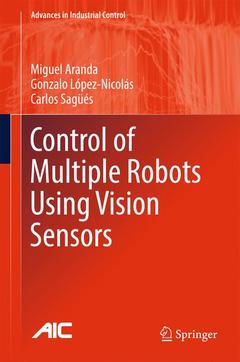Description
Control of Multiple Robots Using Vision Sensors, 1st ed. 2017
Advances in Industrial Control Series
Authors: Aranda Miguel, López-Nicolás Gonzalo, Sagüés Carlos
Language: English
126.59 €
In Print (Delivery period: 15 days).
Add to cartPublication date: 05-2017
Support: Print on demand
126.59 €
In Print (Delivery period: 15 days).
Add to cartPublication date: 07-2018
Support: Print on demand
Description
/li>Contents
/li>Biography
/li>Comment
/li>
This monograph introduces novel methods for the control and navigation of mobile robots using multiple-1-d-view models obtained from omni-directional cameras. This approach overcomes field-of-view and robustness limitations, simultaneously enhancing accuracy and simplifying application on real platforms. The authors also address coordinated motion tasks for multiple robots, exploring different system architectures, particularly the use of multiple aerial cameras in driving robot formations on the ground. Again, this has benefits of simplicity, scalability and flexibility. Coverage includes details of:
- a method for visual robot homing based on a memory of omni-directional images;
- a novel vision-based pose stabilization methodology for non-holonomic ground robots based on sinusoidal-varying control inputs;
- an algorithm to recover a generic motion between two 1-d views and which does not require a third view;
- a novel multi-robot setup where multiple camera-carrying unmanned aerial vehicles are used to observe and control a formation of ground mobile robots; and
- three coordinate-free methods for decentralized mobile robot formation stabilization.
The performance of the different methods is evaluated both in simulation and experimentally with real robotic platforms and vision sensors.
Control of Multiple Robots Using Vision Sensors will serve both academic researchers studying visual control of single and multiple robots and robotics engineers seeking to design control systems based on visual sensors.Miguel Aranda graduated in telecommunication engineering and received the Ph.D. degree in systems engineering and computer science from Universidad de Zaragoza, Spain. Currently, he is a postdoctoral researcher at Institut Pascal in Clermont-Ferrand, France. He previously held a postdoctoral researcher position at Universidad de Zaragoza, within Instituto de Investigación en Ingeniería de Aragón. His research interests include the autonomous navigation and control of mobile robots using visual sensing, and problems related with the coordinated control of multiagent systems.
Gonzalo López-Nicolás received the degree in industrial engineering and the Ph.D. degree in systems engineering and computer science from Universidad de Zaragoza, Spain. He is currently an Associate Professor with the Departamento de Informática e Ingeniería de Sistemas, Universidad de Zaragoza. He is also a Member of the Robotics, Perception and Real-Time Group and of Instituto de Investigación en Ingeniería de Aragón. His research interests are focused on visual control, multirobot systems, autonomous robot navigation, and the application of computer vision to robotics.
Carlos Sagüés received the M.Sc. and Ph.D. degrees from Universidad de Zaragoza, Spain. During the course of his Ph.D. he worked on force and infrared sensors for robotics. In 1994, he became an Associate Professor with the Departamento de Informática e Ingeniería de Sistemas, Universidad de Zaragoza, where he has also occupied the Head Teacher position. Since 2009, he has been a Full Professor with this department. He is a member of Instituto de Investigación en Ingeniería de Aragón. His current research interests include control systems, computer vision, visual robot navigation, and multivehicle cooperative control.Presents integrated treatment of multirobot coordination drawing on aspects of motion control, coordination, and computer vision
Provides novel control algorithms and system architectures to address key issues in vision-based control and team coordination
Assesses performance of theoretical methods using experiments with multiple real robots and various motion tasks
Includes supplementary material: sn.pub/extras
Includes supplementary material: sn.pub/extras




